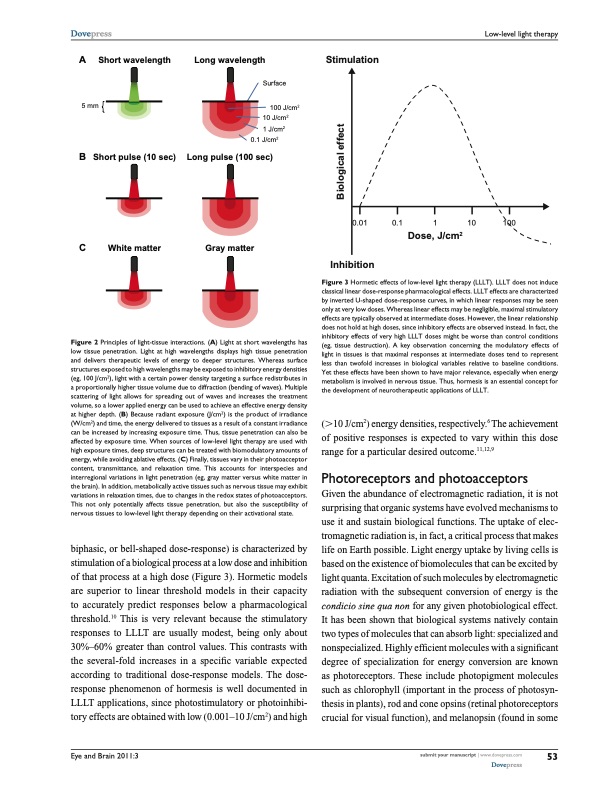
PDF Publication Title:
Text from PDF Page: 005
Dovepress A Short wavelength 5 mm Low-level light therapy Long wavelength Surface 100 J/cm2 10 J/cm2 1 J/cm2 0.1 J/cm2 Long pulse (100 sec) Gray matter Stimulation B C Short pulse (10 sec) White matter 0.01 Inhibition 0.1 1 Dose, J/cm2 10 100 Figure 2 Principles of light-tissue interactions. (A) Light at short wavelengths has low tissue penetration. Light at high wavelengths displays high tissue penetration and delivers therapeutic levels of energy to deeper structures. whereas surface structures exposed to high wavelengths may be exposed to inhibitory energy densities (eg, 100 J/cm2), light with a certain power density targeting a surface redistributes in a proportionally higher tissue volume due to diffraction (bending of waves). Multiple scattering of light allows for spreading out of waves and increases the treatment volume, so a lower applied energy can be used to achieve an effective energy density at higher depth. (B) Because radiant exposure (J/cm2) is the product of irradiance (w/cm2) and time, the energy delivered to tissues as a result of a constant irradiance can be increased by increasing exposure time. Thus, tissue penetration can also be affected by exposure time. when sources of low-level light therapy are used with high exposure times, deep structures can be treated with biomodulatory amounts of energy, while avoiding ablative effects. (C) Finally, tissues vary in their photoacceptor content, transmittance, and relaxation time. This accounts for interspecies and interregional variations in light penetration (eg, gray matter versus white matter in the brain). in addition, metabolically active tissues such as nervous tissue may exhibit variations in relaxation times, due to changes in the redox states of photoacceptors. This not only potentially affects tissue penetration, but also the susceptibility of nervous tissues to low-level light therapy depending on their activational state. biphasic, or bell-shaped dose-response) is characterized by stimulation of a biological process at a low dose and inhibition of that process at a high dose (Figure 3). Hormetic models are superior to linear threshold models in their capacity to accurately predict responses below a pharmacological threshold.10 This is very relevant because the stimulatory responses to LLLT are usually modest, being only about 30%–60% greater than control values. This contrasts with the several-fold increases in a specific variable expected according to traditional dose-response models. The dose- response phenomenon of hormesis is well documented in LLLT applications, since photostimulatory or photoinhibi- tory effects are obtained with low (0.001–10 J/cm2) and high Eye and Brain 2011:3 Figure 3 Hormetic effects of low-level light therapy (LLLT). LLLT does not induce classicallineardose-responsepharmacologicaleffects.LLLTeffectsarecharacterized by inverted U-shaped dose-response curves, in which linear responses may be seen only at very low doses. whereas linear effects may be negligible, maximal stimulatory effects are typically observed at intermediate doses. However, the linear relationship does not hold at high doses, since inhibitory effects are observed instead. in fact, the inhibitory effects of very high LLLT doses might be worse than control conditions (eg, tissue destruction). A key observation concerning the modulatory effects of light in tissues is that maximal responses at intermediate doses tend to represent less than twofold increases in biological variables relative to baseline conditions. Yet these effects have been shown to have major relevance, especially when energy metabolism is involved in nervous tissue. Thus, hormesis is an essential concept for the development of neurotherapeutic applications of LLLT. (.10 J/cm2) energy densities, respectively.6 The achievement of positive responses is expected to vary within this dose range for a particular desired outcome.11,12,9 Photoreceptors and photoacceptors Given the abundance of electromagnetic radiation, it is not surprising that organic systems have evolved mechanisms to use it and sustain biological functions. The uptake of elec- tromagnetic radiation is, in fact, a critical process that makes life on Earth possible. Light energy uptake by living cells is based on the existence of biomolecules that can be excited by light quanta. Excitation of such molecules by electromagnetic radiation with the subsequent conversion of energy is the condicio sine qua non for any given photobiological effect. It has been shown that biological systems natively contain two types of molecules that can absorb light: specialized and nonspecialized. Highly efficient molecules with a significant degree of specialization for energy conversion are known as photoreceptors. These include photopigment molecules such as chlorophyll (important in the process of photosyn- thesis in plants), rod and cone opsins (retinal photoreceptors crucial for visual function), and melanopsin (found in some submit your manuscript | www.dovepress.com Dovepress 53 Biological effectPDF Image | Low-level light therapy of the eye and brain

PDF Search Title:
Low-level light therapy of the eye and brainOriginal File Name Searched:
Low-level_light_therapy_of_the_eye_and_brain.pdfDIY PDF Search: Google It | Yahoo | Bing
Cruise Ship Reviews | Luxury Resort | Jet | Yacht | and Travel Tech More Info
Cruising Review Topics and Articles More Info
Software based on Filemaker for the travel industry More Info
The Burgenstock Resort: Reviews on CruisingReview website... More Info
Resort Reviews: World Class resorts... More Info
The Riffelalp Resort: Reviews on CruisingReview website... More Info
| CONTACT TEL: 608-238-6001 Email: greg@cruisingreview.com | RSS | AMP |